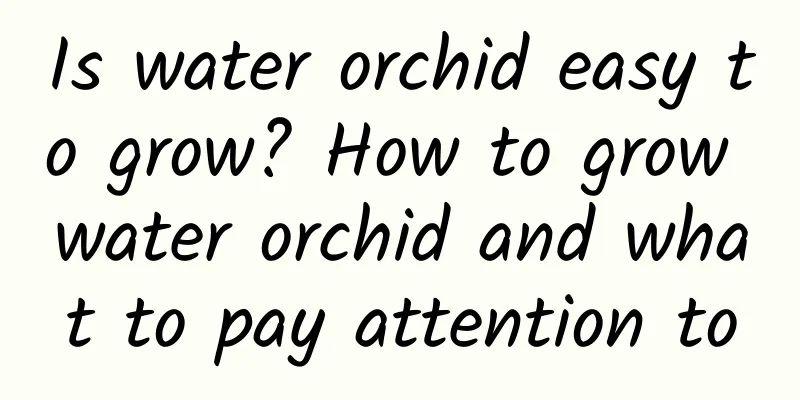When a small pill made of rice water was sprinkled into the flower pots, 20 pots of flowers died overnight. Why?

The roots of newly planted flowers rotted as soon as they were fertilizedNewly transplanted plants are either weak or have many wounds. At this time, they are affected by external stimuli, the wounds heal slowly, and fertilization can easily cause root rot. When traveling on business or just moving to a new place, you often suffer from acclimatization, cold, fever and diarrhea. Taking "tonics" at this time will only "add fuel to the fire". Fertilizing sick plants attracts insects and turns leaves yellowSick and weak plants have thin branches, poor photosynthesis, slow metabolism, and cannot absorb fertilizers, which will cause fertilizer damage! Think about it, can you still eat delicious food when you are sick? The weak cannot be nourished, and the same goes for growing flowers. If you have just recovered from a serious illness and your breath is weak, your roots are weak, and if you use too much fertilizer and water, you will surely die! Fertilize during flowering, flowers, leaves and fruits fallDuring the flowering period, the nutrients of the plant need to be concentrated so that the flowers can be large and numerous. It is best not to apply fertilizer during this period, otherwise it will cause buds, flowers and fruits to fall off! The reason is very simple. After the roots get fertilizer, it is easy to grow side buds. All the nutrients are supplied to the side buds, which will cause the flowers to fail to bloom and the buds and flowers to fall off! The correct time to apply fertilizer is before flowering, during the flower bud differentiation period, to promote more bud formation! Fertilization during dormancy can cause root burn or deathWhether it is summer dormancy or winter dormancy, do not apply fertilizer. Fertilization can easily cause root burn, and in severe cases it may even cause death! During the dormant period, the plant grows slowly or even stops growing. It requires very little nutrients and no fertilizer is needed at all. Fertilizing under the roots will lose nutrientsThe rhizome is the root and the base of the stem close to the root. The root systems of some plants expand very quickly. If you apply fertilizer at the rhizome, it will be difficult for other places to absorb nutrients! For plants with well-developed root systems, you need to loosen the topsoil first, then apply fertilizer along the edge of the pot, allowing it to penetrate little by little so that it can be fully absorbed and utilized. The roots will burn if concentrated fertilizer is appliedToo high a concentration of fertilizer or too much fertilizer will cause root burn and plant death! The correct way to fertilize is to apply thin fertilizers frequently. Three parts fertilizer and seven parts water is the safest. Raw manure smells bad and attracts insectsRaw fertilizer is uncomposted fertilizer. Not only will it attract insects and emit a foul odor, but if it is buried in the soil and fermented in water, it will also cause root burn! In daily life, it is best to dilute rice water, leftover tea, etc. with water and ferment them for a few days before using them to water the flowers. Applying nitrogen fertilizer alone is uselessNitrogen fertilizer promotes plant growth and lush branches and leaves. Applying nitrogen fertilizer alone can easily cause the plant to grow too tall, not bloom, or have small and light-colored flowers! The correct way to fertilize is to use a combination of nitrogen, phosphorus and potassium fertilizers. During the seedling and growth periods, nitrogen fertilizers should be used mainly, while phosphorus and potassium fertilizers should be used mainly before and after flowering. |
Recommend
What is the best season to plant mint? What is the best month to start planting?
There are many methods for growing mint, includin...
What is the appropriate planting density and yield for cowpea planting?
Cowpea planting spacing When planting cowpea, the...
Can hibiscus be pruned in autumn? (When and how to prune hibiscus)
Is it okay to prune hibiscus in autumn? The pruni...
How to grow Buddha belly bamboo
1. Soil To cultivate Buddha belly bamboo, you nee...
How do succulents spend the winter? How do succulents spend the winter on the balcony?
1. Stay warm Succulents are usually not resistant...
Planting methods and time of southern white radish Optimal planting time and technical management
Suitable planting time for white radish in the so...
When does Clivia bloom?
1. Flowering Season Clivia usually blooms in spri...
How to care for Christmas cactus after repotting
1. Time to change pots The climatic conditions in...
Cultivation methods and precautions of grass plum
1. Lighting The plants need to be shaded in the e...
When do petunias bloom?
1. Flowering Season Petunias mostly bloom in summ...
Can asparagus fern be placed in the living room?
1. Financial luck From its name we can know that ...
How to grow lucky bamboo in soil
1. Breeding environment 1. Soil: When growing luc...
Why do wolfberry leaves turn yellow?
Causes and treatment methods The main reasons for...
How to maintain Jade Dew and make it grow well
Jade Dew Growing Conditions Jade plant is native ...
How to plant pansy? Planting time and method
Pansy planting time Pansies prefer a relatively c...









